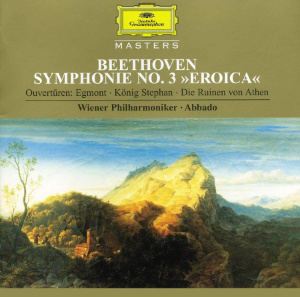
Ludwig van Beethoven (1770-1827)
Symphony No. 3 in E-flat, Op 55 ‘Eroica’ (1803-04)
Overture, Egmont, Op 84 (1810)
Overture, König Stephan, Op 117 (1811)
Overture, Die Ruinen von Athens, Op 113 (1811)
Vienna Philharmonic Orchestra/Claudio Abbado
rec. live, June 1985 (op 55) & February, 1987 (Op 84), Musikverein, Grosser Sall, Vienna; 1988, Konzerthaus, Grosser Saal, Vienna (Opp 113 & 117)
Presto CD
Deutsche Grammophon 445 603-2 [72]
I believe this well-filled disc was most recently issued by DG in their ‘Masters’ series; it has now been licensed by Presto Classical, who have restored it to circulation as part of their ever-expanding catalogue of on-demand discs. The collection includes two overtures recorded under studio conditions in December 1988, but the bulk of the disc’s contents stem from live performances given a couple of years earlier.
In the last fifty years or so there has been a plethora of HIP performances and recordings of Beethoven by specialist ensembles. Not only that but the ‘lean’ approach to such music has greatly influenced many ‘mainstream’ performers. I like very much the lean, muscular and lithe HIP-influenced approach to the music of Beethoven’s era; equally, though, I enjoy and have learned much from the more traditional performances conducted by the likes of Erich Kleiber or Otto Klemperer (to take two names entirely at random). This Abbado performance of the ‘Eroica’ would certainly come into the category of “full fat” Beethoven in the sense that a large orchestra is deployed. However, anyone who passes this performance by, simply because it’s not ‘lean’ in conception or sound will be missing a great deal.
The huge first movement is expertly shaped and paced. Though Abbado is using a full-sized orchestra he never lets the size of the ensemble weigh the performance down. On the contrary, there’s plenty of urgency and the rhythms are strongly articulated. That said, the sheer depth of sound is impressive in its own right, especially when there’s so much shading and dynamic contrast in the performance, both here and in the other movements. The exposition repeat is observed. Abbado’s conception of the first movement is on a grand scale but he always maintains focus and momentum, bringing out the drama in the music. The impressive orchestral sound is founded upon rock-solid double basses. This is a big, powerful performance but it’s also one that is full of nuance. For me, Abbado really shows the stature of this movement.
He and the VPO dig deep in the Marcia funebre. This is a penetrating reading that makes the most of Beethoven’s harmonic tension; listening to it is a profound experience. The fugato episode (from 7:10) is intense and dramatic. The Scherzo is nimble; in the Trio the VPO horns are predictably excellent. In the finale Beethoven builds an imposing edifice on a fairly simple theme. The quick variations are invested with life and brio while in the slower variations (from 6:29) Abbado gives the music just the right amount of breadth without slowing excessively. The coda is properly heroic, the horns prominent. Though it’s a live recording there’s no applause at the end – nor are there any extraneous noises to distract the listener.
Splendidly played and stylishly conducted, this is an ‘Eroica’ of no little stature.
The account of the Egmont overture is equally distinguished. The opening is big and imposing; there’s wonderful weight of string tone in the early bars. The main Allegro section is thrusting and dynamic while the end of the piece is both uplifting and exciting. Robert Simpson points out in his notes that this concluding orchestral blaze represents the fanfare which, in Goethe’s play, the Duke of Alva causes to be played in order to drown Egmont’s final speech. That may be so but, surely, Beethoven’s music here signifies the triumph of the human spirit? The other two overtures, as Simpson candidly points out, are not in this class. Each was written as part of incidental music for two plays by August von Kotzebue (1761-1819). König Stephan is definitely not top-drawer Beethoven, something which even a performance of this quality can’t disguise. The short overture to Die Ruinen von Athens is better, I think. Its first two sections don’t outstay their welcome, while the main Allegro, ma no troppo is purposeful and bracing – at least, it is in this performance. Abbado and the VPO do both of these overtures well.
This is a disc of distinguished Beethoven performances. Once again, Presto Classical have done collectors a signal service by rescuing from the vaults of one of the major labels a disc which would never have been deleted if there was any justice in this world. The recorded sound is good, as is the documentation. Interestingly, DG’s booklet provides a good, succinct essay in English by Robert Simpson as well as two essays by different authors in German.
Help us financially by purchasing from



















